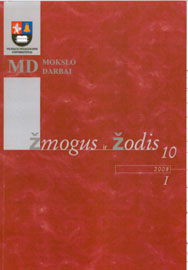Dalykinių tekstų daiktavardžių ir būdvardžių kirčiuočių dažnumas
Frequency of Stressed Nouns and Adjectives within Professional Texts
Author(s): Vida ŽilinskienėSubject(s): Language and Literature Studies
Published by: Vytauto Didžiojo Universitetas
Keywords: frequency dictionary; nouns; adjectivs; stress paradigm; frequency
Summary/Abstract: The aim of this study is to establish which stressed nouns and adjectives are most frequent in the professional texts. It may help to understand which stressed words should be given more attention in the learning / teaching and speaking process in order to avoid the most characteristic stress misuse that disrupts the system of a standard language. On the basis of computerized iterative dictionary of professional style, the frequency of stress paradigms of nouns and adjectives is being discussed. The calculation of iterative dictionary is based on texts chosen at random from Lithuanian publications and papers published in 1990-1995. The subject of investigation is the correlations of stress paradigms of nouns and adjectives within zones of large, medium and small frequency. The following conclusions have been drawn: 1. The most frequent within Lithuanian professional texts are root stress nouns (76.52%), the majority of which being 1st stress paradigm words (47.67%). 2. The most frequently used nouns of 1st stress paradigm are usually stressed on a penultimate syllable (31.99%), and subsequent syllable has mainly falling accent (30.43%). The most frequently used nouns of 1st stress paradigm are derivatives with suffix -ýba, -ýbė. 3. The third (28.85%) of the most frequently used nouns are of 1st stress paradigm (56.09% have a rising accent). The most frequent derivatives of suffixed nouns are words with suffixes -ìmas, -õvas, -ė, -eñtas, -ūrà. 4. The correlations of stress paradigms of nouns within zones of medium and small frequency is similar to that of large requency, but the number of root stress nouns is increasing while the number of nouns stressed at the ending is decreasing. 5. Among frequently used adjectives preponderate (64.21%) root stress words of 1st stress paradigm (45.53%).6. The most frequently used adjectives of 1st and 2nd stress paradigm are derivatives with suffix –ìnis,-ė. They comprise 84.28% of all 1st stress paradigm and 93.78% of all 2nd stress paradigm used adjectives. 7. The correlation of stress paradigms of adjectives within zones of medium and small frequency is similar to that of large frequency too, only the number of 1st stress paradigm words is increasing and that of 3rd stress paradigm is decreasing.
Journal: Žmogus ir žodis
- Issue Year: 10/2008
- Issue No: 1
- Page Range: 118-126
- Page Count: 9
- Language: Lithuanian

